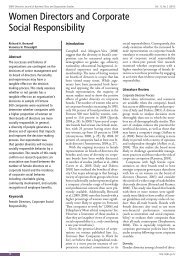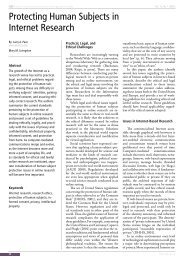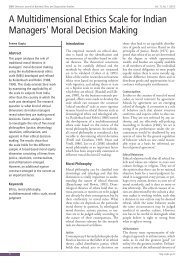View PDF - Electronic Journal of Business Ethics and Organization ...
View PDF - Electronic Journal of Business Ethics and Organization ...
View PDF - Electronic Journal of Business Ethics and Organization ...
- TAGS
- electronic
- ethics
- ejbo.jyu.fi
You also want an ePaper? Increase the reach of your titles
YUMPU automatically turns print PDFs into web optimized ePapers that Google loves.
EJBO <strong>Electronic</strong> <strong>Journal</strong> <strong>of</strong> <strong>Business</strong> <strong>Ethics</strong> <strong>and</strong> <strong>Organization</strong> Studies Vol. 16, No. 1 (2011)<br />
Defining br<strong>and</strong> objectives<br />
According to de Chernatony (2003), the br<strong>and</strong>’s vision should<br />
be expressed as clear long-term <strong>and</strong> short-term objectives to establish<br />
what the br<strong>and</strong> is expected to achieve at specified times.<br />
Definite long-term objectives should be established, <strong>and</strong> then<br />
constantly revisited during the br<strong>and</strong>-development process to<br />
ensure that all levels <strong>of</strong> the organisation are committed to them.<br />
The long-term objectives are then broken down into shorterterm<br />
goals.<br />
Crane (2005) contended that the building <strong>of</strong> responsible<br />
br<strong>and</strong>s requires the adoption <strong>of</strong> a holistic long-term approach.<br />
Because trust <strong>and</strong> credibility cannot be established instantaneously,<br />
corporate actions should be directed towards the longer<br />
term, rather than merely being a ‘spur-<strong>of</strong>-the-moment’ activity<br />
that aims to make a quick pr<strong>of</strong>it. This view was shared by Maio<br />
(2003), who also recommended that responsible br<strong>and</strong>s require<br />
a comprehensive long-term strategy.<br />
Implementation<br />
No matter how thoroughly a company builds its br<strong>and</strong> internally,<br />
a responsible br<strong>and</strong> can succeed only if it is communicated<br />
effectively to potential consumers. The implementation stage is<br />
therefore crucial.<br />
The implementation stage includes both positioning <strong>and</strong> execution<br />
(Aaker, 2002; de Chernatony, 2003; Urde, 2003; Schultz,<br />
2005; Wheeler, 2006; Ghodeswar, 2008; Merrilees & Miller,<br />
2008). Br<strong>and</strong> positioning refers to the creation <strong>of</strong> a perception<br />
<strong>of</strong> the br<strong>and</strong> in the minds <strong>of</strong> customers, <strong>and</strong> the achievement<br />
<strong>of</strong> differentiation; in other words, the br<strong>and</strong> must st<strong>and</strong> apart<br />
from competitors’ br<strong>and</strong>s <strong>and</strong> meet the needs <strong>and</strong> expectations<br />
<strong>of</strong> consumers (Ghodeswar, 2008). Br<strong>and</strong> execution refers to the<br />
communication <strong>of</strong> the br<strong>and</strong>’s message <strong>and</strong> the management<br />
<strong>of</strong> assets to ensure that what is promised is actually delivered<br />
(Urde, 2003; Ghodeswar, 2008; Wheeler, 2006).<br />
In summary, the implementation stage entails publicising the<br />
message <strong>of</strong> the br<strong>and</strong>, ensuring that the message reaches its target<br />
<strong>and</strong> making sure it is delivered.<br />
According to Crane (2005), consumers <strong>and</strong> other stakeholders<br />
are dem<strong>and</strong>ing that companies show more responsibility<br />
while simultaneously being quick to denounce those same companies<br />
for perceived hypocrisy with regard to br<strong>and</strong> images <strong>and</strong><br />
corporate activities. In a similar vein, Maio (2003) emphasised<br />
EXECUTION<br />
IMPLEMENTATION<br />
POSITIONING<br />
EVALUATION<br />
Figure 1. A conceptual model for building responsible br<strong>and</strong>s.<br />
IDENTIFYING<br />
VISION<br />
BUILDING<br />
RESPONSIBLE<br />
BRANDS<br />
DEFINING BRAND<br />
OBJECTIVES<br />
SHORT-‐TERM LONG-‐TERM<br />
the importance <strong>of</strong> matching the ‘talk’ with the ‘walk’, <strong>and</strong> Jahdi<br />
<strong>and</strong> Acikdilli (2009) have noted that organisations that choose<br />
to highlight their CSR credentials come under greater scrutiny<br />
than those that do not do so.<br />
Evaluation<br />
After implementation, the ensuing activities <strong>and</strong> results associated<br />
with the br<strong>and</strong> need to be evaluated. Because they are complex<br />
entities, no single parameter can be used for such evaluation;<br />
rather, a combination <strong>of</strong> internal <strong>and</strong> external dimensions needs<br />
to be measured to assess the success <strong>of</strong> the br<strong>and</strong> (de Chernatony,<br />
2003). Schultz (2005) also advocated comprehensive<br />
monitoring, but took the idea further by suggesting that various<br />
stakeholders should be brought together in the monitoring.<br />
She also contended that the tracking <strong>of</strong> internal <strong>and</strong> external<br />
br<strong>and</strong> performance should be aligned. Finally, by comparing results<br />
with the vision, it is possible to evaluate whether the br<strong>and</strong><br />
objectives have been reached. The evaluation stage also provides<br />
an opportunity to review the whole br<strong>and</strong>-building process with<br />
a view to identifying what needs to be improved.<br />
A conceptual model for building responsible br<strong>and</strong>s<br />
To summarise the above discussion on building responsible<br />
br<strong>and</strong>s, Figure 1 presents a model for building such br<strong>and</strong>s. The<br />
model depicts the six key aspects <strong>of</strong> br<strong>and</strong> building as an interactive<br />
<strong>and</strong> ongoing process.<br />
As shown in Figure 1, the process starts by identifying the<br />
br<strong>and</strong> vision, which is followed by analysis <strong>of</strong> key stakeholders.<br />
The next aspect, creating br<strong>and</strong> identity, can utilise a sense <strong>of</strong><br />
responsibility as a core identity <strong>and</strong>/or as an extended identity.<br />
This is followed by identifying br<strong>and</strong> objectives, which should<br />
be set for both the long term <strong>and</strong> the short term. The next element,<br />
implementation, includes both positioning the br<strong>and</strong> <strong>and</strong><br />
executing the br<strong>and</strong> message. Finally, evaluation <strong>of</strong> the entire<br />
process <strong>and</strong> the br<strong>and</strong> itself completes the process <strong>and</strong> leads to<br />
possible changes.<br />
It would seem that every aspect <strong>of</strong> building responsible br<strong>and</strong>s<br />
requires more thoroughness than building general br<strong>and</strong>s. For<br />
example, the building <strong>of</strong> a responsible br<strong>and</strong> requires a stronger<br />
vision, value foundation, internal commitment, <strong>and</strong> implementation<br />
than is the case in developing br<strong>and</strong>s in general. Moreover,<br />
responsible br<strong>and</strong>s need to be transparent to enhance their<br />
CUSTOMERS COMPETITORS<br />
ANALYSING KEY<br />
STAKEHOLDERS<br />
CREATING BRAND<br />
IDENTITY<br />
10 http://ejbo.jyu.fi/<br />
SELF<br />
+ OTHER<br />
STAKEHOLDERS<br />
RESPONSIBILITY AS<br />
CORE IDENTITY<br />
RESPONSIBILITY AS<br />
EXTENDED IDENTITY











